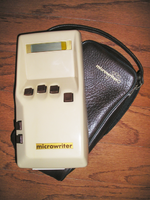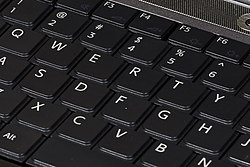
Keyboard (computing)
In computing, a keyboard is an input device partially modelled after the typewriter keyboard which uses an arrangement of buttons, or keys which act as electronic switches. A keyboard typically has characters engraved or printed on the keys, and each press of a key typically corresponds to a single written symbol. However, to produce some symbols requires pressing and holding several keys simultaneously or in sequence. While most keyboard keys produce letters, numbers or signs (characters), other keys or simultaneous key presses can produce actions or computer commands.
In normal usage, the keyboard is used to type text or numbers into a word processor, text editor, or other program. In a modern computer the interpretation of keypresses is generally left to the software. A computer keyboard distinguishes each physical key from every other and reports all keypresses to the controlling software. Keyboards are also used for computer gaming, either with regular keyboards or by using special gaming keyboards which can expedite frequently used keystroke combinations. A keyboard is also used give commands to the operating system of a computer, such as the Control-Alt-Delete combination, which brings up a task window or shuts down the machine.

Standard keyboards
Standard keyboards such as the 104-key Windows keyboards include alphabetic characters, punctuation symbols, numbers, and a variety of function keys. The internationally-common 102/105 key keyboards have a smaller 'left shift' key and an additional key with some more symbols between that and the letter to its right (usually Z or Y).[1]
Keyboards with extra keys such as multimedia keyboards have special keys for accessing music, web, and other oft-used programs, a mute button, volume buttons or knob, and standby (sleep) button. gaming keyboards have extra function keys which can be programmed with keystroke macros. For example, ctrl+shift+y could be a keystroke that is frequently used in a certain computer game. Shortcuts marked on color-coded keys are used for some software applications and for specialized for uses including word processing, video editing, graphic design, and audio editing.
Smaller keyboards have been introduced for laptops, PDAs, cellphones, or users who have a limited workspace. The size of a standard keyboard is dictated by the practical consideration that the keys must be large enough to be easily pressed by fingers. To reduce the size of the keyboard, the numeric keyboard to the right of the alphabetic keyboard can be removed, or the size of the keys can be reduced, which makes it harder to enter text. Another way to reduce the size of the keyboard is to reduce the number of keys and use chording keyer, i.e. pressing several keys simultaneously. For example, the GKOS keyboard has been designed for small wireless devices. Other two-handed alternatives more akin to a game controller, such as the AlphaGrip, are also used as a way to input data and text. Another way to reduce the size of a keyboard is to use smaller buttons and pack them closer together. Such keyboards, often called a "thumbboard" (thumbing) are used in some personal digital assistants such as the Treo and BlackBerry and some Ultra-Mobile PCs such as the OQO.
Numeric keyboards contain only numbers, mathematical symbols for addition, subtraction, multiplication, and division, a decimal point, and several function keys (e.g. End, Delete, etc.). They are often used to facilitate data entry with smaller keyboard-equipped laptops or with smaller keyboards that do not have a numeric keypad.
Non-standard or special-use types
A keyset or chorded keyboard (also called a chord keyboard or chording keyboard) is a computer input device that allows the user to enter characters or commands formed by pressing several keys together, like playing a "chord" on a piano. The large number of combinations available from a small number of keys allows text or commands to be entered with one hand, leaving the other hand free to do something else. A secondary advantage is that it can be built into a device (such as a pocket-sized computer) that is too small to contain a normal sized keyboard. A chorded keyboard designed to be used while held in the hand is called a keyer.

Virtual keyboards, such as the I-Tech Virtual Laser Keyboard, project an image of a full-size keyboard onto a surface. Sensors in the projection unit identify which key is being "pressed" and relay the signals to a computer or personal digital assistant. There is also a virtual keyboard, the On-Screen Keyboard, for use on WIndows.
Touchscreens such as with the iPhone and the OLPC laptop can be used as a keyboard. (The OLPC initiative's second computer will be effectively two tablet touchscreens hinged together like a book. It can be used as a convertible tablet PC where the keyboard is one half-screen (one side of the book) which turns into a touchscreen virtual keyboard.)
Foldable keyboards are made of soft plastic which can be rolled or folded over for travel. When in use, the keyboard can conform to uneven surfaces, and it is more resistant to liquids than a standard keyboard.

Technology
Key switches
"Dome-switch" keyboards (sometimes incorrectly referred to as a membrane keyboards) are the most common type in use in the 2000s. When a key is pressed, it pushes down on a rubber dome sitting beneath the key. A conductive contact on the underside of the dome touches (and hence connects) a pair of conductive lines on the circuit below. This bridges the gap between them and allows electric current to flow (the open circuit is closed). A scanning signal is emitted by the chip along the pairs of lines in the matrix circuit which connects to all the keys. When the signal in one pair becomes different, the chip generates a "make code" corresponding to the key connected to that pair of lines. Keycaps are also required for most types of keyboards; while modern keycaps are typically surface-marked, they can also be 2-shot molded, or engraved, or they can be made of transparent material with printed paper inserts
Keys on older IBM keyboards were made with a "buckling spring" mechanism, in which a coil spring under the key buckles under pressure from the user's finger, pressing a rubber dome, whose inside is coated with conductive graphite, which connects two leads below, completing a circuit. This produces a clicking sound, and gives physical feedback for the typist indicating that the key has been depressed.[2][3]When a key is pressed and the circuit is completed, the code generated is sent to the computer either via a keyboard cable (using on-off electrical pulses to represent bits) or over a wireless connection.




1 comment:
Keyboard description also very nice,
may i know which kind of keyboard is useful for home purpose, and is many key as possible is nice or lesser keys is nice to use?
Post a Comment